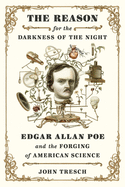
Mention Edgar Allan Poe to most readers and the name will conjure a chilling memory of a macabre tale like "The Pit and the Pendulum," or perhaps an image of a tortured artist who died young. It's almost certain those associations won't connect the writer to the world of science.
The Reason for the Darkness of the Night by John Tresch (The Romantic Machine) may help change that. Tresch, professor of History of Art, Science, and Folk Practice at the Warburg Institute in the University of London, undertakes a comprehensive examination of this little-known and significantly underappreciated facet of Poe's career. It's an admiring, intellectually stimulating portrait of a man Tresch describes as nothing less than "an analyst, a philosopher, and a detective, seeking to crack the code of the universe."
Poe's interest in astronomy dated at least to his teenage years, and he studied that subject, along with mathematics and geometry, at West Point. It was an age when science was beginning to professionalize and assume a more prominent role in American life, as the young country began to challenge Britain for primacy in the field. While he was conversant with many of these developments, Poe worked along a parallel path, offering "an alternative vision of science and the cosmos in which intuition, feeling, and imagination played leading roles."
Edgar Allan Poe's status as a major American literary figure is long established. But John Tresch's Reason for the Darkness of the Night now should encourage the curious and open-minded to devote fresh attention to the artist's contributions to the advancement of scientific thought. --Harvey Freedenberg, freelance reviewer

